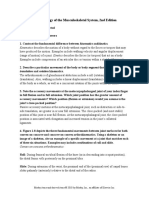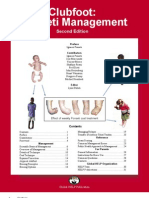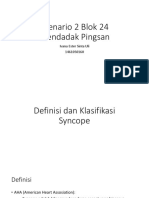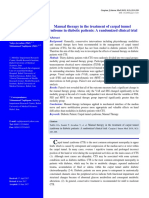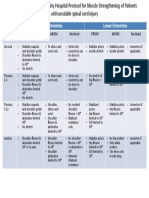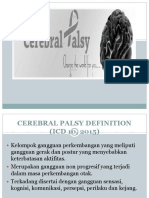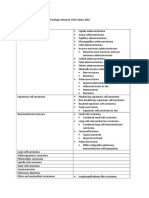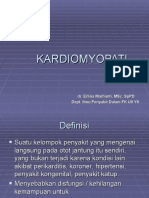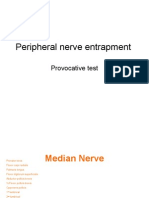Asia Score For Vertebra Injury
Asia Score For Vertebra Injury
Uploaded by
Azwin KamarCopyright:
Available Formats
Asia Score For Vertebra Injury
Asia Score For Vertebra Injury
Uploaded by
Azwin KamarOriginal Description:
Original Title
Copyright
Available Formats
Share this document
Did you find this document useful?
Is this content inappropriate?
Copyright:
Available Formats
Asia Score For Vertebra Injury
Asia Score For Vertebra Injury
Uploaded by
Azwin KamarCopyright:
Available Formats
0 = absent
1 = altered
2 = normal
NT = not testable
ASIA Impairment (AIS) Scale
A = Complete. No sensory or motor function
is preserved in the sacral segments S4-S5.
B = Sensory Incomplete. Sensory but not
motor function is preserved below the
neurological level and includes the sacral
segments S4-S5 (light touch, pin prick at S4-S5:
or deep anal pressure (DAP)), AND no motor
function is preserved more than three levels below
the motor level on either side of the body.
C = Motor Incomplete. Motor function is
preserved below the neurological level**, and
more than half of key muscle functions below the
single neurological level of injury (NLI) have a
muscle grade less than 3 (Grades 0-2).
D = Motor Incomplete. Motor function is
preserved below the neurological level**, and at
least half (half or more) of key muscle functions
below the NLI have a muscle grade > 3.
E = Normal. If sensation and motor function as
tested with the ISNCSCI are graded as normal in
all segments, and the patient had prior deficits,
then the AIS grade is E. Someone without an
initial SCI does not receive an AIS grade.
**For an individual to receive a grade of C or D, i.e. motor
incomplete status, they must have either (1) voluntary anal
sphincter contraction or (2) sacral sensory sparing with
sparing of motor function more than three levels below the
motor level for that side of the body. The Standards at this
time allows even non-key muscle function more than 3 levels
below the motor level to be used in determining motor
incomplete status (AIS B versus C).
NOTE: When assessing the extent of motor sparing below
the level for distinguishing between AIS B and C, the motor
level on each side is used; whereas to differentiate between
AIS C and D (based on proportion of key muscle functions
with strength grade 3 or greater) the single neurological
level is used.
Muscle Function Grading
0 = total paralysis
1 = palpable or visible contraction
2 = active movement, full range of
motion (ROM) with gravity
eliminated
3 = active movement, full ROM against
gravity
4 = active movement, full ROM against
gravity and moderate resistance in a
muscle specific position.
5 = (normal) active movement, full
ROM against gravity and full
resistance in a muscle specific
position expected from an otherwise
unimpaired peson.
5* = (normal) active movement, full
ROM against gravity and sufficient
resistance to be considered normal
if identified inhibiting factors (i.e.
pain, disuse) were not present.
NT= not testable (i.e. due to
immobilization, severe pain such that
the patient cannot be graded,
amputation of limb, or contracture
of >50% of the range of motion).
Steps in Classification
The following order is recommended in determining the
classification of individuals with SCI.
1. Determine sensory levels for right and left sides.
2. Determine motor levels for right and left sides.
Note: in regions where there is no myotome to test, the motor
level is presumed to be the same as the sensory level, if testable
motor function above that level is also normal.
3. Determine the single neurological level.
This is the lowest segment where motor and sensory function is
normal on both sides, and is the most cephalad of the sensory
and motor levels determined in steps 1 and 2.
4. Determine whether the injury is Complete or Incomplete.
(i.e. absence or presence of sacral sparing)
If voluntary anal contraction = No AND all S4-5 sensory
scores = 0 AND deep anal pressure = No, then injury is
COMPLETE. Otherwise, injury is incomplete.
5. Determine ASIA Impairment Scale (AIS) Grade:
Is injury Complete? If YES, AIS=A and can record ZPP
(lowest dermatome or myotome on
each side with some preservation)
Is injury
motor Incomplete? If NO, AIS=B
(Yes=voluntary anal contraction OR
motor function more than three levels
below the motor level on a given side,
if the patient has sensory incomplete
classification)
Are at least half of the key muscles below the
single neurological level graded 3 or better?
If sensation and motor function is normal in all segments, AIS=E
Note: AIS E is used in follow-up testing when an individual with
a documented SCI has recovered normal function. If at initial
testing no deficits are found, the individual is neurologically
intact; the ASIA Impairment Scale does not apply.
NO
YES
NO
AIS=C
YES
AIS=D
You might also like
- The Brain: Our Universe WithinDocument7 pagesThe Brain: Our Universe WithinSally Morem67% (3)
- William Vs MC Kenzie-1Document4 pagesWilliam Vs MC Kenzie-1DefaNo ratings yet
- ASIA ScoreDocument2 pagesASIA ScoreIqbal BaryarNo ratings yet
- Umn LMNDocument18 pagesUmn LMNaria_jayaNo ratings yet
- Neumann: Kinesiology of The Musculoskeletal System, 2nd EditionDocument5 pagesNeumann: Kinesiology of The Musculoskeletal System, 2nd EditionVictor MarianNo ratings yet
- Modalitas: Dr. Octaviany Hidemi M.SPKFRDocument110 pagesModalitas: Dr. Octaviany Hidemi M.SPKFRvidisanjaya21No ratings yet
- Kinesiology ElbowDocument53 pagesKinesiology Elbowsingle_ladyNo ratings yet
- Gullain Barre SyndromeDocument33 pagesGullain Barre SyndromeNor Ubudiah SetiNo ratings yet
- Pre KKD I - Baru NeuroDocument81 pagesPre KKD I - Baru NeuroancillaagraynNo ratings yet
- Effect of Cailliet and Mc. Kenzie Neck Exercise in Reducing Pain in Miofacial Neck Syndrome AbstractDocument5 pagesEffect of Cailliet and Mc. Kenzie Neck Exercise in Reducing Pain in Miofacial Neck Syndrome AbstractVeronika AtaNo ratings yet
- Visual Anatomy and Physiology 3rd Edition Martini Test Bank PDF Download Full Book with All ChaptersDocument41 pagesVisual Anatomy and Physiology 3rd Edition Martini Test Bank PDF Download Full Book with All Chaptersqiaoyupitafi74100% (3)
- Developmental Coordination DisorderDocument7 pagesDevelopmental Coordination DisorderQina Nugroho, pts.No ratings yet
- DiensefalonDocument31 pagesDiensefalonIngrid AykeNo ratings yet
- Guideline - Training New Trainer ISMKI 2016Document18 pagesGuideline - Training New Trainer ISMKI 2016Dhery Dev WhitterNo ratings yet
- Chvostek's Sign and Carpopedal Spasm NEJM APRIL 2009 PDFDocument1 pageChvostek's Sign and Carpopedal Spasm NEJM APRIL 2009 PDFAnonymous uVinWXfo4No ratings yet
- Help CfponsetiDocument32 pagesHelp CfponsetiShAi_MyStERiOuSNo ratings yet
- Operasi Monokular Recess Resect Dengan Teknik: Hangback Pada Exotropia Deviasi BesarDocument10 pagesOperasi Monokular Recess Resect Dengan Teknik: Hangback Pada Exotropia Deviasi BesarBlack Clover IdNo ratings yet
- Responsi Stemi Dr. Tuko SP - JP FixDocument56 pagesResponsi Stemi Dr. Tuko SP - JP FixcintaNo ratings yet
- SyncopeDocument19 pagesSyncopeIvana Ester Sinta UliNo ratings yet
- Upper Extremity Fracture - MKDocument85 pagesUpper Extremity Fracture - MKHawa AmbarwatiNo ratings yet
- Jurnal MusculoDocument8 pagesJurnal MusculoDwy Erna Little AngelNo ratings yet
- Journal of Hand Therapy: Hayat Hamzeh PT, MSC, Mohammad Madi PT, PHD, Alia A. Alghwiri PT, PHD, Ziad Hawamdeh MD, PHDDocument9 pagesJournal of Hand Therapy: Hayat Hamzeh PT, MSC, Mohammad Madi PT, PHD, Alia A. Alghwiri PT, PHD, Ziad Hawamdeh MD, PHDWinda FRNo ratings yet
- Manual Therapy in The Treatment of Carpal Tunnel Syndrome in Diabetic Patients: A Randomized Clinical TrialDocument7 pagesManual Therapy in The Treatment of Carpal Tunnel Syndrome in Diabetic Patients: A Randomized Clinical TrialHerwanda PrasetyoNo ratings yet
- Gambaran Gangguan Otonom Pada Pasien Parkinson Di RSCM Dan RSUP FatmawatiDocument14 pagesGambaran Gangguan Otonom Pada Pasien Parkinson Di RSCM Dan RSUP FatmawatiyurimaNo ratings yet
- Thomas Jefferson University Hospital Protocol For Muscle StrengtheningDocument1 pageThomas Jefferson University Hospital Protocol For Muscle StrengtheningAgus SG100% (1)
- PR Frankel ScoreDocument4 pagesPR Frankel ScoreMuhammad Dony HermawanNo ratings yet
- Penyakit Jantung Bawaan (PJB)Document44 pagesPenyakit Jantung Bawaan (PJB)Jack Flow ClickNo ratings yet
- Penatalaksanaan Fisioterapi Pada LymphedemaDocument19 pagesPenatalaksanaan Fisioterapi Pada Lymphedemamaevy dwiNo ratings yet
- IPA BPSD Educational PackDocument161 pagesIPA BPSD Educational PackbloadyroarNo ratings yet
- Ischialgia TraumatikDocument12 pagesIschialgia TraumatikAnonymous qLL3HUgNo ratings yet
- Foot Drop and Prevention of Foot Drop: Approved By: Write Name of The Unit Nursing HeadDocument10 pagesFoot Drop and Prevention of Foot Drop: Approved By: Write Name of The Unit Nursing HeadSavita HanamsagarNo ratings yet
- 3rd Announcement Konas-IX PerdossiDocument30 pages3rd Announcement Konas-IX PerdossiA Hadid FirdiyanshahNo ratings yet
- Exercise Metabolism, Carbohydrates and LipidsDocument39 pagesExercise Metabolism, Carbohydrates and LipidsMohdSyamRoslanNo ratings yet
- AGE Max HR (220-Age) Max HR (208 - 0.7xage) : Maximum Heart RateDocument10 pagesAGE Max HR (220-Age) Max HR (208 - 0.7xage) : Maximum Heart RateJinaan MahmudNo ratings yet
- Wheelchair Skills Test Questionnaire (WST-Q) Version 5.0 Form Manual WheelchairsDocument2 pagesWheelchair Skills Test Questionnaire (WST-Q) Version 5.0 Form Manual Wheelchairsosama taisirNo ratings yet
- Klasifikasi Tumor Paru Secara Histologis Menurut WHO Tahun 2015Document3 pagesKlasifikasi Tumor Paru Secara Histologis Menurut WHO Tahun 2015lindaNo ratings yet
- Painful Hemiplegic ShoulderDocument53 pagesPainful Hemiplegic ShoulderpipitNo ratings yet
- Anatomy and PhysiologyDocument4 pagesAnatomy and PhysiologySarah CabalquintoNo ratings yet
- Neurologi Klinis DasarklinicDocument19 pagesNeurologi Klinis Dasarklinickloter1No ratings yet
- MNJ ToastDocument4 pagesMNJ ToastRichard SuherlimNo ratings yet
- Journal Reading-DM Hennie Bertha O-16711067Document56 pagesJournal Reading-DM Hennie Bertha O-16711067Suwandi BaskoroNo ratings yet
- Journal Reading Radiologi EllaDocument44 pagesJournal Reading Radiologi EllaElla Putri SaptariNo ratings yet
- Rotator Cuff SyndromeDocument14 pagesRotator Cuff SyndromeRatu Suci Angraini HasibuanNo ratings yet
- Nyeri Punggung Bawah (Low Back Pain) : DefinisiDocument10 pagesNyeri Punggung Bawah (Low Back Pain) : DefinisiheruNo ratings yet
- Spondylitis TBDocument33 pagesSpondylitis TBYohana KoliNo ratings yet
- Efektivitas Peningkatan Aktifitas Fungsional Dengan Intervensi Ice Massage Dan Terapi Latihan Pada Kasus Plantar FasciitisDocument8 pagesEfektivitas Peningkatan Aktifitas Fungsional Dengan Intervensi Ice Massage Dan Terapi Latihan Pada Kasus Plantar FasciitisTiara PutriNo ratings yet
- KARDIOMYOPATI - Kuliah DR - ErlinaDocument28 pagesKARDIOMYOPATI - Kuliah DR - ErlinaArif Zulfian MubarokNo ratings yet
- TENSDocument20 pagesTENSchandran2679100% (2)
- Medical Outcome Study - Short Form (SF-36)Document11 pagesMedical Outcome Study - Short Form (SF-36)Arfia Chowdhury Arifa100% (1)
- Intubasi SulitDocument26 pagesIntubasi SulitfrostedsurgeonNo ratings yet
- Pronator Teres SyndromeDocument14 pagesPronator Teres Syndromeapi-2518191No ratings yet
- Pemanfaatan Epas Pada LBPDocument134 pagesPemanfaatan Epas Pada LBPBesa Erlin PukaNo ratings yet
- Brachial Plexus InjuryDocument23 pagesBrachial Plexus InjuryEdho SumampouwNo ratings yet
- Referat HNPDocument17 pagesReferat HNPROSSA100% (1)
- Isncsci Exam Sheet r4Document2 pagesIsncsci Exam Sheet r4akhmadukiNo ratings yet
- Asia Chart IscosDocument2 pagesAsia Chart IscosJeremiah HiiNo ratings yet
- ASIA Scoring CardDocument2 pagesASIA Scoring CardSomu VictorNo ratings yet
- Thang điểm ASIADocument2 pagesThang điểm ASIADiệu My VươngNo ratings yet
- 0 Absent 1 Altered 2 Normal NT Not TestableDocument2 pages0 Absent 1 Altered 2 Normal NT Not Testablepablo lópezNo ratings yet
- Isncsci Asia Iscos LowDocument2 pagesIsncsci Asia Iscos LowmanuelmayoralNo ratings yet
- ASIA Impairment ScaleDocument10 pagesASIA Impairment Scaleazimahzainal211No ratings yet
- Excell Precision Weighing Scale Manual de UsuarioDocument21 pagesExcell Precision Weighing Scale Manual de Usuarioguztavo2601No ratings yet
- Grade 11 Excel Paper 4Document3 pagesGrade 11 Excel Paper 4ggsilvaboy7No ratings yet
- FSSC 22000 Certification ProcessDocument6 pagesFSSC 22000 Certification Processcollege food&beverageNo ratings yet
- Sources of PoetryDocument10 pagesSources of PoetryGhulamMustafaNo ratings yet
- D. 6. The Collection Development ProsesDocument7 pagesD. 6. The Collection Development ProsesmaydiNo ratings yet
- Term 1 - MathsDocument10 pagesTerm 1 - MathsGaming TriadNo ratings yet
- Course Description 100 LEVEL EPM 111: Principles of Environmental Planning and ManagementDocument8 pagesCourse Description 100 LEVEL EPM 111: Principles of Environmental Planning and ManagementAlvinTiteNo ratings yet
- Edmt281536 FHQ Davma, RZQS, RZQ SeriesDocument156 pagesEdmt281536 FHQ Davma, RZQS, RZQ SeriesPhanhai KakaNo ratings yet
- Samsung EcobubbleDocument840 pagesSamsung EcobubbleAlinaNo ratings yet
- How To Bypass Facebook Phone Number Verification Using 2 Easy WaysDocument5 pagesHow To Bypass Facebook Phone Number Verification Using 2 Easy Waysjulio raimeNo ratings yet
- Amiya MohapatraDocument17 pagesAmiya MohapatraBhavesh PopatNo ratings yet
- First Long Test in Mathematics 8Document3 pagesFirst Long Test in Mathematics 8Raquel YayaNo ratings yet
- Chapter 3 SolutionsDocument15 pagesChapter 3 Solutionsjohn brown100% (2)
- 6A Good and Bad HabitsDocument12 pages6A Good and Bad HabitsSapphire BreezeNo ratings yet
- MathPracticeTestsfortheACT - 2024 - SAMPLEDocument32 pagesMathPracticeTestsfortheACT - 2024 - SAMPLEVibrant PublishersNo ratings yet
- Addition and DeletionDocument10 pagesAddition and DeletionNikkaMontilNo ratings yet
- Yashica FX-D Se PDFDocument46 pagesYashica FX-D Se PDFheraasku7194No ratings yet
- 12.5.13 Packet Tracer - Troubleshoot Enterprise Networks - ILMDocument7 pages12.5.13 Packet Tracer - Troubleshoot Enterprise Networks - ILMAnuar ValdiviNo ratings yet
- Africanus Journal Volume 2 No. 1Document72 pagesAfricanus Journal Volume 2 No. 1Gordon-Conwell Theological SeminaryNo ratings yet
- Preface: SevenDocument60 pagesPreface: Seven24.Mr.Theutthavy Pms 7/6No ratings yet
- SOAL UTS 2020. B.INGGRIS XI FIKdocxDocument9 pagesSOAL UTS 2020. B.INGGRIS XI FIKdocxlatifahNo ratings yet
- PPG - Module 2 - 2ND Sem - 2ND Quarter - Grade 11 - Humss Bonifacio-Agoncillo - MR - Paombong - MRS CuencaDocument12 pagesPPG - Module 2 - 2ND Sem - 2ND Quarter - Grade 11 - Humss Bonifacio-Agoncillo - MR - Paombong - MRS CuencaArnold Paombong100% (1)
- WomeninministryDocument34 pagesWomeninministryzaneleNo ratings yet
- Extract Pages From TeknoDocument1 pageExtract Pages From TeknohereisamitNo ratings yet
- Indian PersonalitiesDocument16 pagesIndian Personalitiessarin15juneNo ratings yet
- TDS - Vinyl 901-3 (En)Document2 pagesTDS - Vinyl 901-3 (En)OXY Composite TechNo ratings yet
- Pr1 ProposalDocument6 pagesPr1 ProposalZenyll Deserei AquinoNo ratings yet
- PI DataLink User Guide PrintableDocument128 pagesPI DataLink User Guide PrintableJoeyNo ratings yet
- Inguinal HerniaDocument7 pagesInguinal HerniaNader Smadi67% (6)




